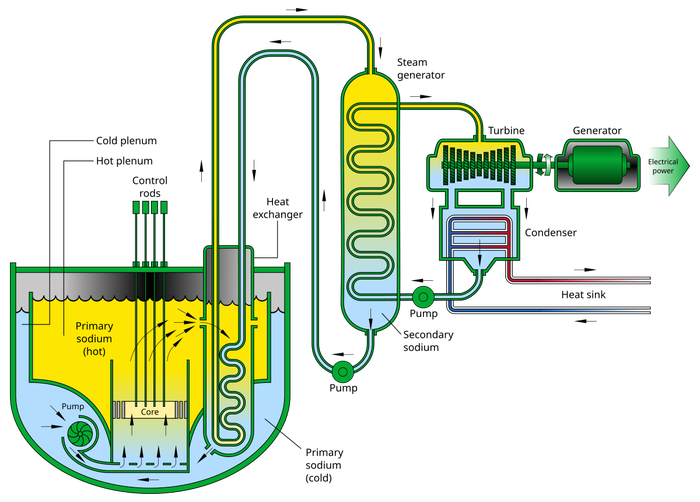Pros and Cons of Sodium-Cooled Nuclear Reactors for Data Center EnergyPros and Cons of Sodium-Cooled Nuclear Reactors for Data Center Energy
Could nuclear reactors cooled by liquid sodium help solve the data center industry's energy woes – or are they still too risky? We weigh the benefits and challenges.
.jpg?width=1280&auto=webp&quality=95&format=jpg&disable=upscale)
Traditionally, cooling nuclear reactors in a safe, reliable way is a challenge – which is one of the reasons why nuclear-powered data centers have not yet become widespread. Liquid sodium could help solve this problem by offering a safer and more efficient means of cooling reactors.
That, at least, is the theory behind sodium-cooled nuclear reactors (also known as sodium-cooled fast reactors), which currently exist in only a handful of locations. Will the theory eventually be put into practice in a way that solves the data center industry's energy woes? Keep reading for perspective.
What is a Sodium-Cooled Nuclear Reactor?
A sodium-cooled nuclear reactor is one that uses liquid sodium to dissipate heat. The use of sodium as a cooling agent distinguishes this type of reactor from conventional reactors, which rely on water as a cooling solution.
Compared to water cooling, sodium-cooled reactors offer two key advantages:
Greater efficiency, because sodium remains an effective cooling medium at higher temperatures than water.
A lower risk of explosion caused by high pressure, since sodium coolants operate at lower pressures than water.

Diagram of a pool type sodium-cooled fast reactor
Sodium Cooling and the Data Center Industry
Sodium-cooled reactors can generate power for any use case, not just data centers. However, recent trends mean that sodium cooling may become especially valuable for the data center industry.
The main reason is that data center energy needs are likely to increase in coming years. Today, data centers account for about 1% of the world's total energy consumption, but some projections suggest that this figure could double as businesses deploy more power-hungry servers to support AI workloads and, generally, scale up their IT infrastructures.
This past June, TerraPower – founded by Bill Gates – made headlines by beginning construction at a 345-MW sodium-cooled fast reactor site in Wyoming with the hope of using the facility to help power AI.
Coupled with ongoing pressure on the industry to operate more sustainably, a rise in energy needs means that data center owners stand to benefit from nuclear power as a relatively inexpensive electricity source that doesn't rely on fossil fuels.
Solving Nuclear Power Woes
Nuclear power is not new, of course, and data centers in parts of the world where nuclear energy is abundant already source power from nuclear reactors. But concerns about the safety risks make it challenging for data center operators to tout nuclear as the perfect solution.
Sodium-cooled reactors, however, could help to change this by offering a nuclear energy solution that is safer than traditional reactors.
The Challenges of Sodium-Cooled Reactors
That said, sodium-cooled reactors are not exactly a perfect energy source for data centers.
One big challenge is that at high temperatures, liquid sodium can burn when exposed to air. As a result, sodium-cooled reactors would require closed systems that isolate the cooling liquid from the ambient environment – and if a leak were to occur, the results could be bad. Relatively minor sodium leaks might not lead to a full-on nuclear meltdown, but they could start fires. Major leaks could render the cooling system ineffective, which would potentially cause reactors to overheat and melt down.
In this sense, sodium-cooled reactors are far from a totally safe type of energy solution. They're arguably safer than water because they can tolerate higher temperatures and pressures, but they are no guarantee against meltdown risks or other problems.
On top of this, it would likely take years to construct enough sodium-cooled reactors to meet the data center industry's electricity needs. Although a handful of sodium-cooled plants are currently in service, most are not in locations with high concentrations of data centers.
Sodium Cooling: A Help, But Not a Complete Solution
For both of these reasons, it's unlikely that data center operators will be able to turn to sodium-cooled reactors anytime soon as a way to source electricity without relying on fossil fuels – or as an alternative to renewable energy, which comes with its own challenges, such as dependency on the weather to produce electricity.
Nonetheless, sodium cooling does promise to help the data center industry take a step towards safer, more reliable nuclear power. And over the long term, improvements in the technology could mitigate the safety issues that currently impact sodium-cooled reactors. But don't expect to see data centers leveraging sodium-cooled nuclear power to go carbon neutral in the near future.
About the Author
You May Also Like









